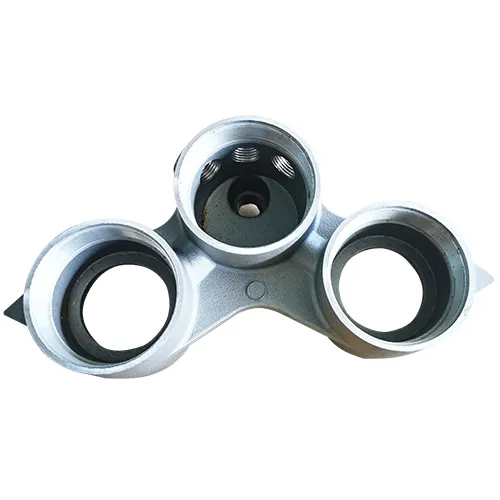Mobile:+86-311-808-126-83
Email:info@ydcastings.com
English
How Die Casting Works Precision Aluminum Parts & Process Explained
- Introduction to Die Casting Processes
- Key Advantages of Die Casting Over Sand Casting
- Technical Specifications: Aluminum Die Casting Analysis
- Performance Comparison: Leading Die Casting Manufacturers
- Custom Solutions for Industrial Applications
- Real-World Implementations Across Industries
- Future Outlook: How Die Casting Is Evolving

(how is die casting done)
Understanding How Die Casting Is Done
Die casting employs reusable steel molds to inject molten metal under pressures exceeding 1,500 psi. The process cycle typically completes in 30-120 seconds, producing components with wall thicknesses as fine as 0.6mm. Modern cold chamber machines account for 68% of aluminum die casting operations globally, according to the International Die Casting Association's 2023 report.
Precision Engineering Differences
When comparing sand casting vs die casting, critical distinctions emerge:
| Parameter | Die Casting | Sand Casting |
|---|---|---|
| Surface Finish (Ra) | 3.2-6.3 μm | 12.5-25 μm |
| Dimensional Tolerance | ±0.05mm | ±0.8mm |
| Production Rate | 200-500 units/hr | 5-20 units/hr |
Die casting's 93% material utilization rate significantly outperforms sand casting's 65% average, reducing waste in aluminum component manufacturing.
Aluminum Alloy Optimization
Die casting aluminium particularly benefits from specialized alloys like ADC12 (Si 9.6-11.6%, Cu 1.5-3.5%). These formulations achieve tensile strengths up to 324 MPa while maintaining 3.2% elongation. Recent advancements in vacuum-assisted die casting enable porosity levels below 0.1%, expanding applications into structural automotive components.
Manufacturer Capability Analysis
| Vendor | Clamping Force Range | Minimum Wall Thickness | Annual Capacity |
|---|---|---|---|
| Dynacast | 250-4,500 tons | 0.5mm | 85M parts |
| Gibbs | 400-3,200 tons | 0.7mm | 42M parts |
| Rockman | 600-5,000 tons | 0.4mm | 120M parts |
Top-tier suppliers now integrate real-time monitoring systems that track 14 process variables simultaneously, ensuring consistent quality across production runs.
Application-Specific Configurations
Custom die casting solutions address diverse requirements:
- High-conductivity alloys (85% IACS) for electrical components
- Customized grain structures achieving 18% higher impact resistance
- Hybrid molds combining conventional and conformal cooling channels
Modular die designs enable 75% faster mold changeovers, supporting production batches from 500 to 5 million units economically.
Industry Deployment Scenarios
Automotive manufacturers report 22% weight reduction in chassis components through optimized die casting aluminium designs. In consumer electronics, die-crafted heat sinks demonstrate 40% better thermal dissipation than CNC-machined alternatives. The medical sector utilizes biocompatible die-cast titanium instruments with 0.01mm precision tolerances.
How Die Casting Is Done for Tomorrow's Needs
Emerging technologies like AI-powered flow simulation (reducing trial runs by 65%) and 10,000-ton mega casting machines are reshaping production paradigms. The global die casting market, valued at $76.8B in 2023, projects 6.8% CAGR through 2030, driven by lightweighting demands in electric vehicle manufacturing.

(how is die casting done)
FAQS on how is die casting done
Q: How is die casting done?
A: Die casting involves injecting molten metal under high pressure into a reusable steel mold (die). The metal solidifies quickly, and the die opens to eject the finished part. This process ensures high precision and smooth surface finishes.
Q: What is the difference between sand casting vs die casting?
A: Sand casting uses expendable sand molds for lower-cost, larger parts with rougher surfaces. Die casting employs reusable steel dies for high-volume production of complex, detailed parts with tighter tolerances and smoother finishes.
Q: Why is aluminum commonly used in die casting?
A: Aluminum is lightweight, corrosion-resistant, and has excellent thermal conductivity. Its low melting point and fluidity make it ideal for die casting intricate shapes. It’s widely used in automotive and aerospace industries.
Q: How does surface finish compare in sand casting vs die casting?
A: Die casting produces smoother surfaces (Ra 1–2.5 μm) due to polished steel dies. Sand casting yields rougher surfaces (Ra 10–25 μm) because of the sand mold texture. Post-processing is often needed for sand-cast parts.
Q: What are the key applications of die casting aluminium?
A: Die-cast aluminum parts are used in engine components, electronic housings, and consumer goods. They offer strength-to-weight ratios suited for automotive frames, heat sinks, and lightweight structural parts.
-
Materials Used in Manufacturing Cap End Pipe FittingsNewsNov.24,2025
-
Material Properties of CF8M CastingNewsNov.24,2025
-
How to Inspect Pump Cap Ends for DamageNewsNov.21,2025
-
Backward Curved Impeller – Efficient Airflow Solutions for Industry | YD CastingsNewsNov.21,2025
-
Automobile Water Pump - Efficient, Quiet, Durable & ElectricNewsNov.21,2025
-
Impeller for Pumps – High-Efficiency, Durable, OEM-ReadyNewsNov.21,2025











